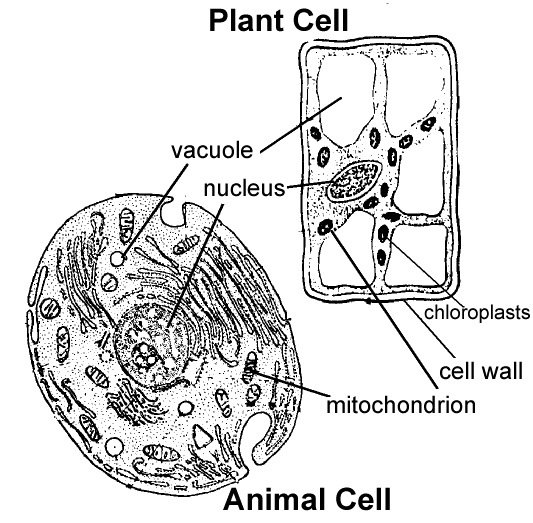|
MICROSCOPE/CELLS
MATERIALS:
transmitted light microscope
toothpick
iodine stain (or any other available)
glass slide
celery cells
onion
slides prepared
cover slips
medicine dropper with water
BACKGROUND INFORMATION:
The cell is the fundamental structural unit of living
things or the basic unit of life. Plant cells can best be observed under a
transmitted light microscope. Therefore, two properties of the specimen are
important: transparency of the object and the medium that it is placed. Stains
can help us look at cells much better because they darken certain areas we
wish to look at.
In this activity students will make wet mounts of celery
cells and onion cells, one with a stain and one without. They will conclude
that stained cells can be examined much more easily.
Cells are the fundamental units of all organisms. Some organisms made up of only one cell, but many more organisms are made of billions of cells. A cell is a packaged power plant that maintains all necessary functions in order to stay alive. All cells have certain components that enable them to carry out vital life processes. There are several different types of specialized cells, but emphasize to students the basic structure of the cell.
 A cell has several components that perform different functions. The vital parts of a cell are called "organelles." Among the most important are the nucleus, vacuoles, and mitochondria, all of which are enclosed within the cell membrane and immersed in cytoplasm. A cell has several components that perform different functions. The vital parts of a cell are called "organelles." Among the most important are the nucleus, vacuoles, and mitochondria, all of which are enclosed within the cell membrane and immersed in cytoplasm.
Each organelle performs a specific task that helps keep the cell alive. In both an animal and plant cell, the nucleus, vacuoles, mitochondrion, cell membranes, and cytoplasm can be found.
The nucleus is the control center of cell activity and contains the genetic material that is important for cell division. The structures that resemble air bubbles are called vacuoles. Some vacuoles store food for future use while other store wastes until they are removed. Since the cell is a living entity, it needs energy. The energy that a cell uses is produced in the mitochondrion which releases sugar and starches that is used as fuel by the cell. Most of the parts of the cell are surrounded by a cell membrane. The function of the membrane is to allow only certain fluids and chemicals into and out of the cell. Cells contain a thick substance called cytoplasm which is capable of maintaining the life processes. The name of the protoplasm within the nucleus is called nucleoplasm.
A plant cell also contains chloroplasts and a cell wall. Chloroplasts are the photosynthesis center of a plant cell. It converts light into energy. It contains chlorophyll which gives it the green color we associate with plants. The cell wall gives plant cell a rigid support and protects the cell.
In most plants and animals, the cells are organized to do different types of jobs. In plants, for instance, there are specialized root cells whose function is to take in minerals and water. These specialized cells are arranged into tissues that do the same job. Muscle tissue, for example, is made up of many individual muscle cells. Different tissues that work together form organs. Examples of organs include the stomach, kidneys, and lungs. Organs are groups of tissues that work together to perform a specific function. Organs do not operate in isolation and together they form systems, like the respiratory, circulatory, and digestive systems.
PROCEDURE:
Have the students make their own wet mounts. Go over the
procedure for making wet mounts, depending on the equipment that you have.
Have students make a mount of celery cells and onion skin without stain. Have
them look under the microscope. Have them stain the cells and then look again.
Students should record all observations by drawing what they see.
BIOLOGICAL SCIENCES-MICROSCOPE/CELLS
PROBLEM: Do stained cells look better than non-stained cells?
HYPOTHESIS:____________________________________________________________________
PROCEDURE:
MATERIALS: light microscope, toothpick, onion, celery cells, cover
slips, slides, iodine
Follow wet mount instructions from your teacher. MAKE A WET MOUNT OF YOUR
CELERY CELLS AND ONION CELLS. Draw what you see under high power.
ADD IODINE to your cell preparation. Draw what you see under high power.
|